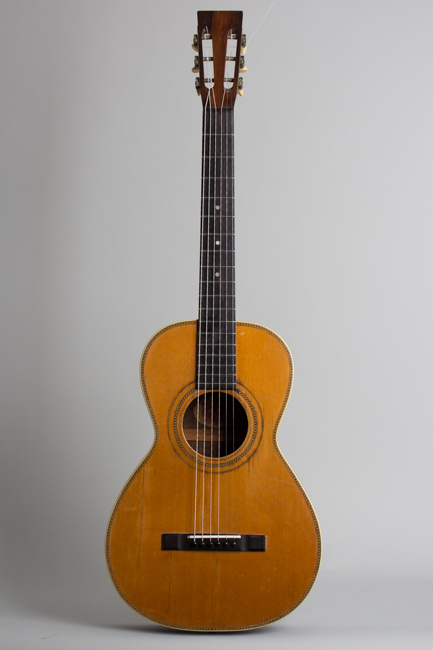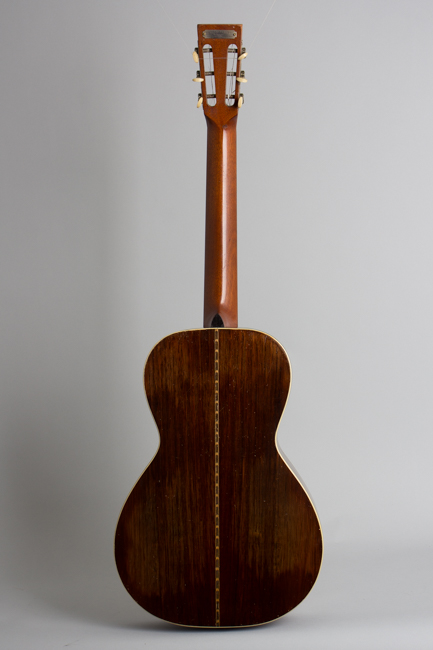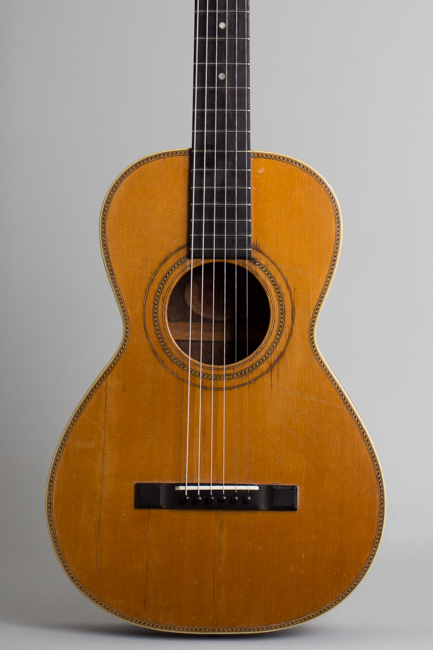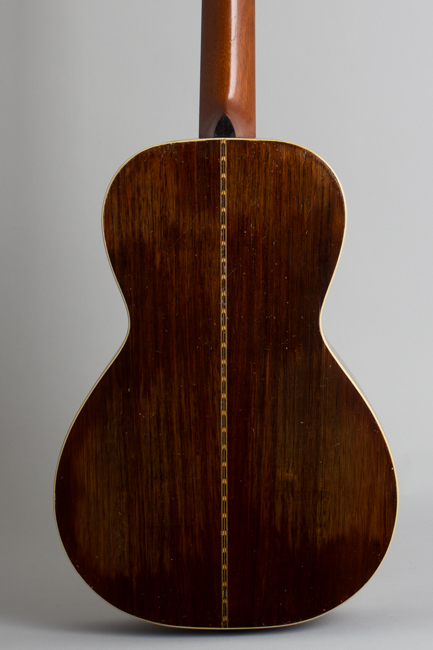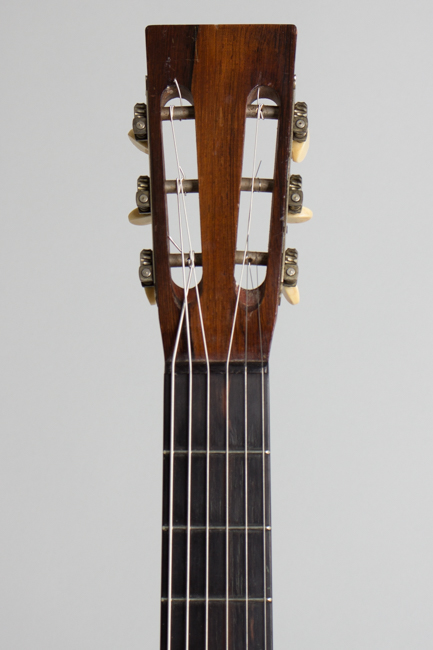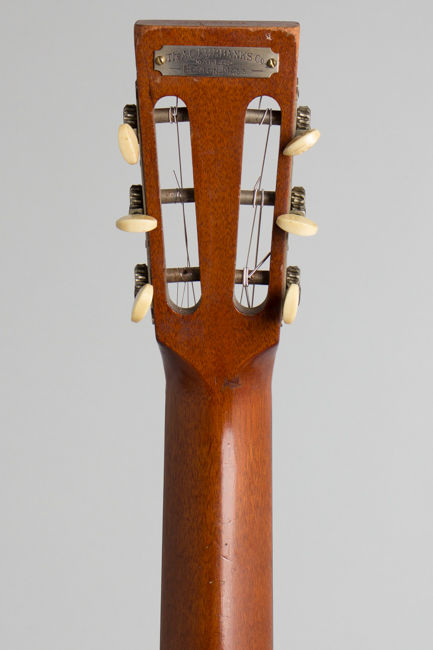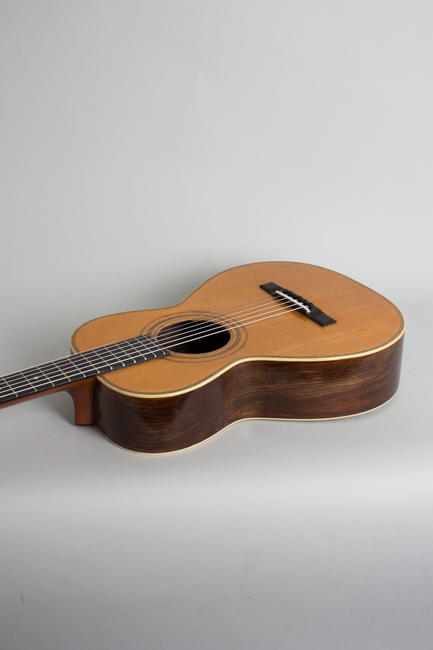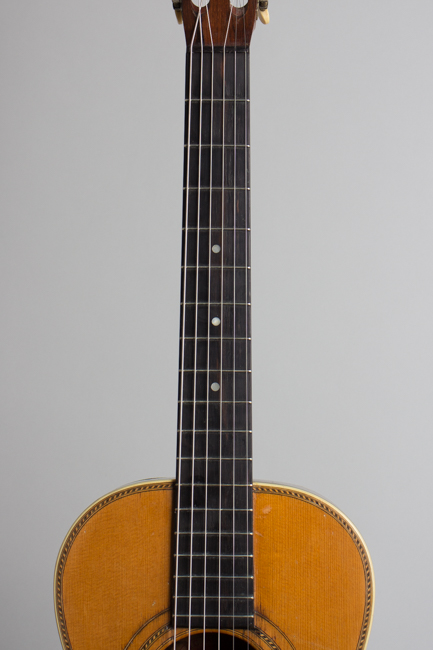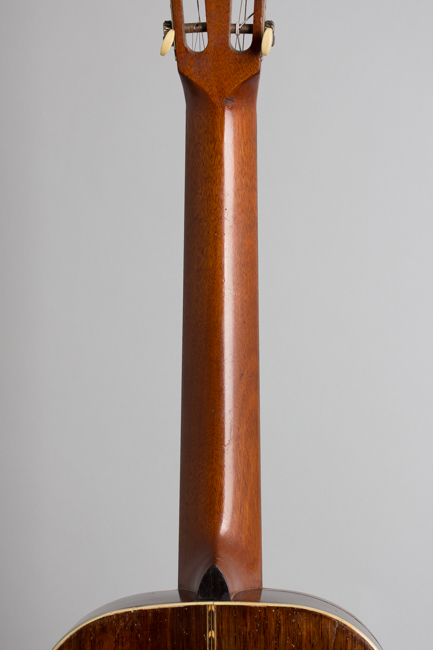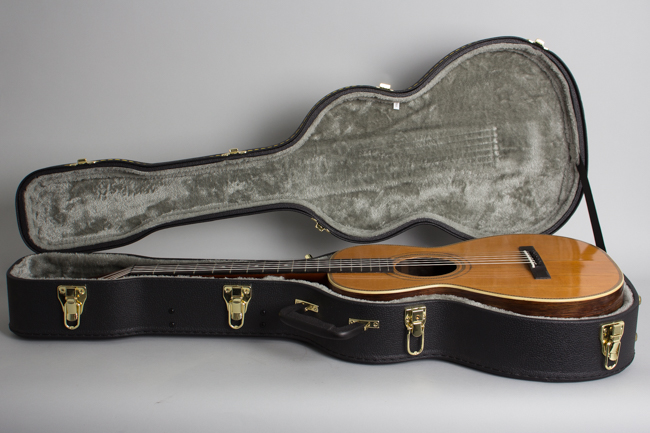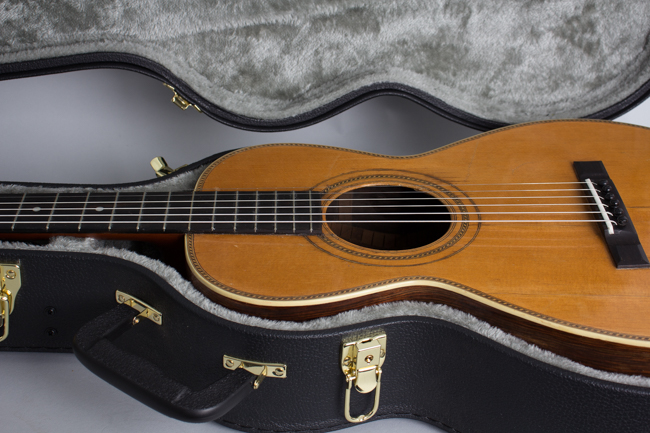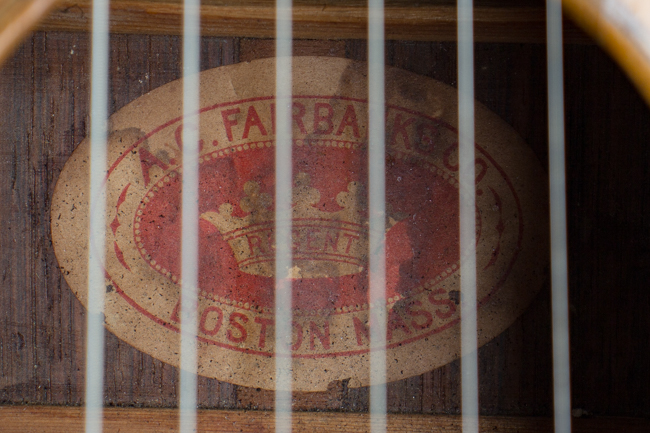Fairbanks Regent Flat Top Acoustic Guitar , c. 1900
This item has been sold.
Item # 9985
Prices subject to change without notice.
Fairbanks Regent Model Flat Top Acoustic Guitar, c. 1900, made in Boston, Mass., serial # 38984, natural varnish finish, Brazilian rosewood back and sides, spruce top; mahogany neck with ebony fingerboard, black tolex hard shell case.
While the A.C. Fairbanks company is justly renowned as the most important name in banjos at the turn of the last century, the other instruments carrying their name are often forgotten. Before being taken over by Vega in 1904 Fairbanks also offered mandolins and guitars, and if they are not as distinctive and well remembered as the company's banjos, they still maintain the quality inherent in all Fairbanks instruments. This guitar is a very nice example of these rare Boston made instruments, one of the few we have ever seen.
This lovely little guitar is typical of the era, not quite 13" wide with beautiful Brazilian rosewood back and sides and red spruce top. The top and back are bound in ivoroid, the top edge and soundhole ring are bordered with half-herringbone marquetry and the back features an elaborate chain pattern backstrip. The bridge and fingerboard are ebony. The neck has a softer "V" profile than many period guitars and is quite comfortable to play. All workmanship is exceptionally neat both inside and out.
The entire guitar is very lightly built, with a ladder braced top and thin maple bridgeplate. There is an A.C. Fairbanks label under the soundhole and the famous Fairbanks nameplate pinned to the back of the headstock (Steal this for a banjo dowel and face bad guitar karma forever!). The serial number is a different series than Fairbanks banjos; it is not possible to date the guitar exactly but it would not have been built later than 1904. This guitar has seen some wear and repair over the last century but now plays perfectly and has a wonderful tone, even with silk-and-steel strings (the heaviest we would recommend) one of the best sounding small-body guitars of this type we have had.
Overall length is 37 in. (94 cm.), 12 3/4 in. (32.4 cm.) wide at lower bout, and 3 7/8 in. (9.8 cm.) in depth at side, taken at the end block. Scale length is 24 3/4 in. (629 mm.). Width of nut is 1 13/16 in. (46 mm.).
This guitar has seen a decent amount of wear and repair work over the last 120 years or so but plays very well and sounds great, with a huge tone belying its small size. The original finish has dings, dents and scrapes overall and appears to have been polished out, especially on the back and sides. The neck finish is surprisingly clean with only a few small dents.
There are numerous repaired spruce grain splits to the top with a number of cleats inside, and a small patch added under the top just behind the very thin bridgeplate as reinforcement. The area where the fingerboard extension meets the soundhole edge has some less than perfect looking old repair with some staining into the finish, but is fully solid. Both sides also have a number of grain splits to the rosewood with a couple of small fills, while the back shows only one tight split on the lower waist.
The neck has been neatly reset, and we would assume it has been refretted at some point though the older-style wire is fairly thin. The ebony bridge is a reproduction in the original style. The early Handel tuners (the same as used by Martin and Gibson) remain original. While far from pristine this is still a lovely little guitar and a very fine playing instrument, a testament to the always top-notch workmanship of its Boston maker. It is housed in a well-fitted modern HSC. Overall Very Good + Condition.
While the A.C. Fairbanks company is justly renowned as the most important name in banjos at the turn of the last century, the other instruments carrying their name are often forgotten. Before being taken over by Vega in 1904 Fairbanks also offered mandolins and guitars, and if they are not as distinctive and well remembered as the company's banjos, they still maintain the quality inherent in all Fairbanks instruments. This guitar is a very nice example of these rare Boston made instruments, one of the few we have ever seen.
This lovely little guitar is typical of the era, not quite 13" wide with beautiful Brazilian rosewood back and sides and red spruce top. The top and back are bound in ivoroid, the top edge and soundhole ring are bordered with half-herringbone marquetry and the back features an elaborate chain pattern backstrip. The bridge and fingerboard are ebony. The neck has a softer "V" profile than many period guitars and is quite comfortable to play. All workmanship is exceptionally neat both inside and out.
The entire guitar is very lightly built, with a ladder braced top and thin maple bridgeplate. There is an A.C. Fairbanks label under the soundhole and the famous Fairbanks nameplate pinned to the back of the headstock (Steal this for a banjo dowel and face bad guitar karma forever!). The serial number is a different series than Fairbanks banjos; it is not possible to date the guitar exactly but it would not have been built later than 1904. This guitar has seen some wear and repair over the last century but now plays perfectly and has a wonderful tone, even with silk-and-steel strings (the heaviest we would recommend) one of the best sounding small-body guitars of this type we have had.
Overall length is 37 in. (94 cm.), 12 3/4 in. (32.4 cm.) wide at lower bout, and 3 7/8 in. (9.8 cm.) in depth at side, taken at the end block. Scale length is 24 3/4 in. (629 mm.). Width of nut is 1 13/16 in. (46 mm.).
This guitar has seen a decent amount of wear and repair work over the last 120 years or so but plays very well and sounds great, with a huge tone belying its small size. The original finish has dings, dents and scrapes overall and appears to have been polished out, especially on the back and sides. The neck finish is surprisingly clean with only a few small dents.
There are numerous repaired spruce grain splits to the top with a number of cleats inside, and a small patch added under the top just behind the very thin bridgeplate as reinforcement. The area where the fingerboard extension meets the soundhole edge has some less than perfect looking old repair with some staining into the finish, but is fully solid. Both sides also have a number of grain splits to the rosewood with a couple of small fills, while the back shows only one tight split on the lower waist.
The neck has been neatly reset, and we would assume it has been refretted at some point though the older-style wire is fairly thin. The ebony bridge is a reproduction in the original style. The early Handel tuners (the same as used by Martin and Gibson) remain original. While far from pristine this is still a lovely little guitar and a very fine playing instrument, a testament to the always top-notch workmanship of its Boston maker. It is housed in a well-fitted modern HSC. Overall Very Good + Condition.
